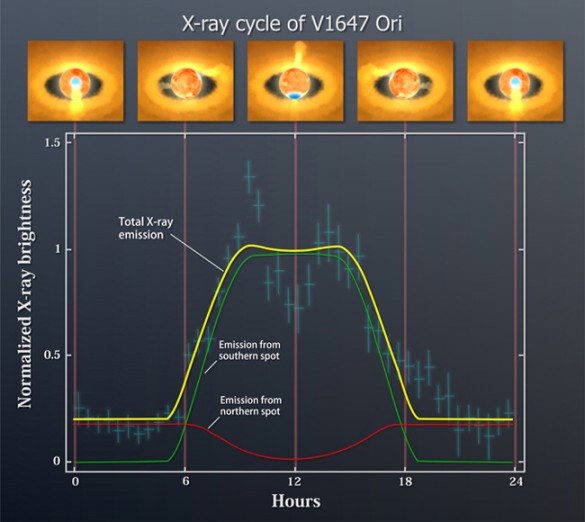
The latest observations of a newly born star have found that it has a pair of spots on its surface that are heated to more than one million degrees. The presence of these spots, which are hot enough to produce X-ray radiation, confirms a theory for how stellar infants grow which Professor of Astronomy David Weintraub and his colleague Joel Kastner from Rochester Institute of Technology advanced several years ago.
The stellar infant in question, labeled V1647 Ori, burst into visibility in 2004 when it flared up a hundredfold in brightness. It pumped out enough visible light to illuminate the dark cloud of dust and gas surrounding it, allowing Jay McNeil, an amateur astronomer in western Kentucky, to spot its appearance in the vicinity of the Orion Nebula.

Discovery of an embryonic star like this is an exceedingly rare event, having occurred only a few times in the last century, and it is the first that has been caught in the act of flaring in modern times when its behavior can be monitored in radio, infrared and X-ray wavelengths, as well as in visible light.
When they heard of the discovery, Weintraub and Kastner got special permission for viewing time on NASA’s Chandra X-ray Observatory because the flaring episodes of newborn stars are normally short in duration. This allowed them to determine that V1647 Ori was a strong X-ray source while it was flaring but that its X-ray emissions weakened and disappeared as the flare died away. These measurements confirmed that the physical process that produces the flare in visible light also produces the X-rays.
Many stars, including the sun, generate X-rays by a mechanism that depends on the star’s rotation rate and convection depth. However, the established mechanism could not explain the pattern of changes in intensity or the temperature of the protostar’s X-ray emissions. That led Weintraub and Kastner to propose that both the visible and X-ray flare-ups were caused when large clumps of dust and gas fall onto the surface of the protostar from a dense disk of dust and gas called a protoplanetary disk that surrounds the protostar. The young protostar’s rotation should generate intense magnetic fields that act like invisible funnels that direct large slugs of electrically charged dust and gas down to the surface. The protostar’s rotation rate should also wind up the magnetic fields, stretching them until they break. Each time the field lines break, they should deposit enough energy into the dust and gas to heat it to the million degree plus temperatures required to generate the X-ray signals that they observed.
“Twenty years ago, everyone thought that protostars grew by gradually absorbing material that slowly fell onto them from their surrounding disks of dust and gas,” said Weintraub. “Now we suspect that they grow by a series of big gulps.”
During outbursts, the X-ray emissions of the infant star in McNeil’s Nebula may brighten 100-fold. In this animation, magnetic fields drive powerful flows of dust and gas onto the star, creating two hot spots that produce the high-energy X-ray emissions. (NASA’s Goddard Space Flight Center)
When V1647 Ori flared up again in 2008, a team of astronomers including Weintraub and Kastner were ready. They pointed a trio of orbiting X-ray telescopes – Chandra, the Japan-led Suzaku satellite and the European XMM satellite – at the still-forming star. A new study based on these observations, scheduled for publication in the July 20 issue of The Astrophysical Journal, has confirmed that intense magnetic fields funnel torrents of dust and gas down to two spots on the protostar’s surface and, in the process, heat them to the high temperatures required to produce X-ray radiation.
The new observations also allowed the scientists to determine the rotation rate of the youngster.
“One of the most interesting findings is the fact that the star is rotating once every 24 hours,” said Weintraub. “Just a little bit faster and it would break up!”
While the process of absorbing material from the protoplanetary disk increases a forming star’s rotation rate, for the same reason that spinning skaters spin faster when they pull their arms in toward their bodies, young stars are also good at getting rid of their spin energy. By the time a young protostar is a million years old, they typically rotate in five to ten days. Over their billions-of-years lifetimes, they lose more and more angular momentum. Mature stars like the Sun rotate very slowly, with periods of 20 to 30 days.

The extremely fast rotation rate of V1647 Ori, combined with observations that show the stellar infant is still partly swaddled in its birth cloud and is still growing by gulping more mass, have led the scientists to estimate that it is very young, only 100,000 years old. With a rotation rate of only one day, this is one of the fastest-rotating Sun-like stars known and therefore perhaps one of the youngest.
“Now we just have to figure out what slows them down,” said Weintraub. “ While we know they must slow down, the mechanism as to how that happens remains a real mystery.”